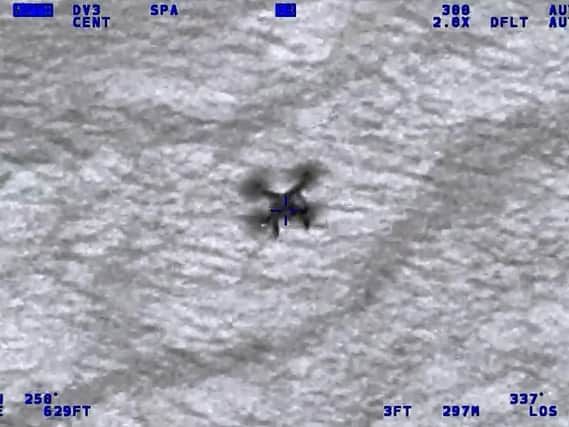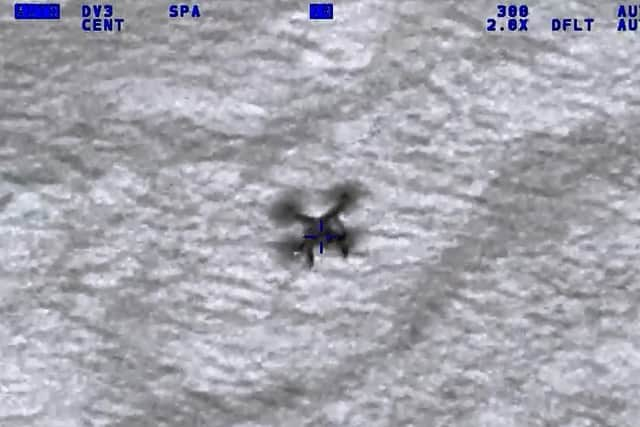Drone could have caused police helicopter '˜catastrophe' in Guyhirn as man sentenced in first UK case


Sergej Miaun became the first person in the UK to be prosecuted for flying a drone which interfered with a police vehicle after he disrupted a search for a missing woman in the River Nene in Guyhirn.
Peterborough Magistrates’ Court heard that the National Police Air Service had to take “evasive action” on December 9 last year due to the safety risk caused by the drone, which was being controlled by Miaun at his home half a mile away.
Advertisement
Hide AdAdvertisement
Hide AdPolice aborted their search of the river in the dark to follow the device back to the 37-year-old’s garden in High Road, Guyhirn, before searching his property and finding it hidden in a loft hatch above his bath.


The court was told Miaun twice denied having a drone before it was discovered.
The defendant, who could follow the £900 Phantom 4’s path through an iPad, claimed he was in control of the flight at all times and that the drone was never more than approximately 420m away.
However, his testimony was rejected as the drone’s flight path showed it had travelled half a mile away.
Advertisement
Hide AdAdvertisement
Hide AdMiaun was found guilty by magistrates after a trial having previously denied the charges.
Sentencing him last week, chief magistrate Hilary Glover told the defendant: “You could not reasonably be satisfied that the flight could be safely made. We consider this to be reckless, especially considering the possible serious consequences of your actions.”
Acting Sergeant Darren Gore said: “This is the first conviction of this type in the UK. It should serve as a warning to all people flying drones that they need to be operated within the limits of the law.
“This incident could have ended very differently had the police helicopter not taken evasive action whilst dealing with another serious incident.
Advertisement
Hide AdAdvertisement
Hide AdThe verdict followed testimony from Captain Lee Holmes who flew the police helicopter.
Captain Holmes said it “came as a great surprise” when the drone first appeared on the screen they were using to try and find the missing woman.
He added: “My first assumption was it was being used by the fire brigade or the police and we were not aware of it. We quickly established that was not the case.
“The problem is we did not know its size or scale and didn’t know what we were dealing with or who was controlling it.
Advertisement
Hide AdAdvertisement
Hide Ad“We assumed the person was in the water but had to forget about that because I had something in my air space.”
After losing sight of the drone Captain Holmes had to take “evasive action” to bring the helicopter further up so he could “build up situational awareness”.
He added: “For five minutes I don’t know where the drone is.
“You see in Leicester when it goes wrong it’s catastrophic.”
Advertisement
Hide AdAdvertisement
Hide AdHaving aborted their search for the woman the crew then followed the drone back to Miaun’s house half a mile away.
“It took me by surprise how quick it could go,” said Captain Holmes.
PC Anthony Johnson from the National Police Air Service also gave evidence.
He said the people on board the helicopter “could not see (the drone) out of the window with the naked eye,” adding: “The fact the drone was in the vicinity of the aircraft meant it was dangerous, whether I could see it or not.”
Advertisement
Hide AdAdvertisement
Hide AdPCSO Lisa Mann was instructed to attend Miaun’s home after it was identified the drone had landed in his garden.
She told the court that Miaun refused to provide ID and “denied flying the drone. He said possibly a neighbour was flying it”.
She claimed she was shouted at to leave.
Acting Sergeant Gore was next to attend the house. He arrested Miaun then searched the property.
He said: “It took sometime but I did find it just within the loft hatch in the bathroom, above the bath.”
Advertisement
Hide AdAdvertisement
Hide AdMiaun was alleged to have told police he kept it there to “protect it from the children”.
Speaking in English, but with help at times from a Russian interpreter, Miaun said he decided to fly the drone out to the A47 - next to the river - as he saw police lights there and thought there could be an accident.
He added: “I saw my own drone and the flashing lights on the A47. It was a nice clear sky and stars.
“After three minutes I realised the helicopter was there. It switched on a big light. I turned (the drone) around and it went back to my garden.”
Advertisement
Hide AdAdvertisement
Hide AdMiaun said the drone had four flashing lights - two red and two green.
He continued: “It was a safe distance. If I interrupted the pilot I did not really want to so I apologise for that.”
Cross-examining, prosecutor Mike Pryor told Miaun: “You sent out the drone - you were not thinking if it’s safe.”
Miaun, who it was noted was of previous good character, was found guilty of failing to maintain direct, unaided visual contact with a small unmanned aircraft and flying a small unmanned aircraft when not reasonably satisfied that the flight can be safely made.
Advertisement
Hide AdAdvertisement
Hide AdHe received a £184 fine, costs of £250 and had to pay a £30 victim surcharge. The total added up to £464.
The magistrates also ordered the forfeiture of the drone, which Miaun said cost £900 to buy.